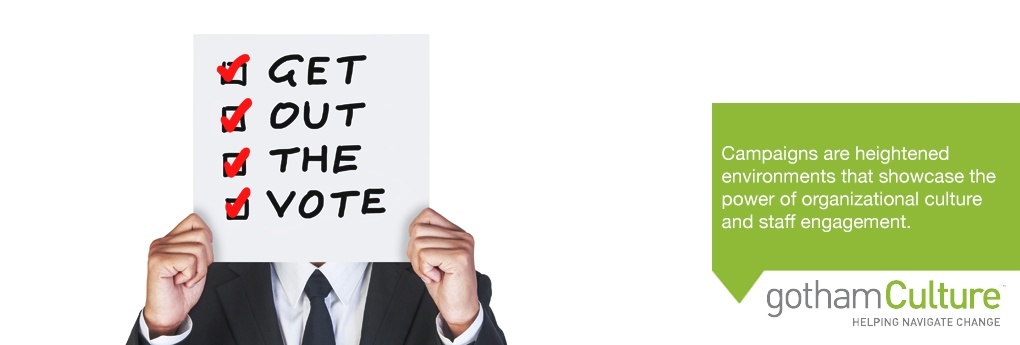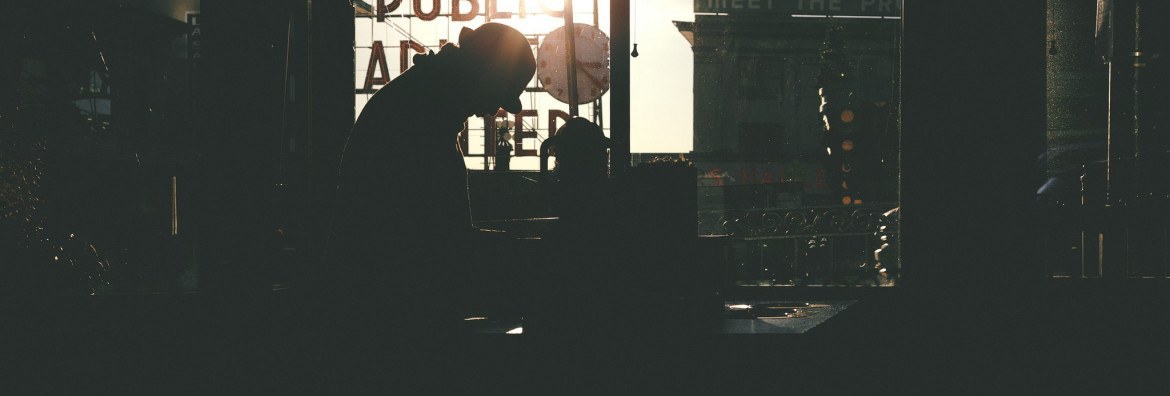Starbucks has gained a lot of attention in the wake of their recent dress code policy changes, allowing their employees to wear black denim, colored ties, and allowing visible tattoos.
This may seem like a small change, but in the context of recent controversy over this very issue, it made us wonder what the deeper implications were for these policy changes.
We asked our team at gothamCulture how they viewed this recent change, and what bigger implications for the coffee giant’s organizational culture may be underlying it. Here are some of our thoughts:
Stuart Farrand – Associate
 I’d say its 60% PR and 40% pragmatism and believe the two go hand in hand. A growing percentage of the population has tattoos, especially within the services industry. At the moment, having a tattoo doesn’t carry the stigma it used to. In fact, it’s become more of a cultural norm.
I’d say its 60% PR and 40% pragmatism and believe the two go hand in hand. A growing percentage of the population has tattoos, especially within the services industry. At the moment, having a tattoo doesn’t carry the stigma it used to. In fact, it’s become more of a cultural norm.
From a PR standpoint, it did seem that Starbucks was out of touch with society. From a pragmatic standpoint, I think they realized that tattoos are really not something they can control. It’s much easier to acquiesce than to make the dress code more restrictive (i.e. wearing long sleeves to cover up tattoos, regulating the color of the long sleeve shirt, etc.), which would also be more difficult to enforce.
In terms of what other organizations might learn from this, I see two big takeaways:
1. Weigh the costs and benefits of the rules you impose on your employees. Dress code is a good example, but it the same is true for broader rules across your organization. At what point do the rules (and enforcing the rules) actually impede someone’s ability to do their job?
2. Organizations must be flexible with emerging social norms, and try to accommodate them as much as possible.
Samantha Goldman – Associate
 This is a great example of an organization updating a policy to act more in accordance with its values and mission, and thereby preserve its own integrity as an organization. The anti-tattoo policy or a very strict dress code did seem to be in contradiction with Starbucks first value of “Creating a culture of warmth and belonging, where everyone is welcome”. It also undermines their mission, “To inspire and nurture the human spirit – one person, one cup and one neighborhood at a time.”
This is a great example of an organization updating a policy to act more in accordance with its values and mission, and thereby preserve its own integrity as an organization. The anti-tattoo policy or a very strict dress code did seem to be in contradiction with Starbucks first value of “Creating a culture of warmth and belonging, where everyone is welcome”. It also undermines their mission, “To inspire and nurture the human spirit – one person, one cup and one neighborhood at a time.”
While any organization must have some guidelines for physical appearance/dress code, employees can’t be blatantly prohibited from showing up physically in a way that reflects their own human spirits, especially when “warmth and belonging” are guiding values in the brand’s interaction with customers. Such policies are a critical component of an organization’s culture. If the organization is trying to create a culture that reflects their mission and values, it’s critical that policies are aligned as much as possible.
Mark Emerson – General Manager
 Starbucks is bowing to the inevitable shift to a new generation. This is a push/pull situation, in that their customers are younger, and the younger generation doesn’t view body art as any big deal. And, in most cases it is an expression of individuality – which pulls the company forward.
Starbucks is bowing to the inevitable shift to a new generation. This is a push/pull situation, in that their customers are younger, and the younger generation doesn’t view body art as any big deal. And, in most cases it is an expression of individuality – which pulls the company forward.
Then you have the push aspect. The company wants to show they are keeping with the times. What better way to do that than to have their baristas reflect a large portion of their customer base? This feeds very much into the culture and system of values Starbucks wants to reflect: one of making the employees the bottom-line and everything else will flow from that.
Secondly, and I think Starbucks is always looking at the practicality of things. They were probably starting to run into a recruitment issue. They are, in some ways, the “McDonald’s of coffee” and provide starter jobs for many teens/twenty-somethings. Banning tattoos was bound to trip them up with their enormous staffing needs.
This also reminds me of the story in the NY Times about the Starbucks worker who was having so much trouble getting steady work hours and trying to care for her young son. Literally, within one day of the story coming out, the company changed its global policy and vowed to make hours more steady for it workers.
What other corporation of this size would make such a change so rapidly, simply because it is the right thing to do? They could simply have said they’d ‘study’ the problem, but they massively adjusted their entire work process because of their culture of putting employees first.
Dustin Schneider – Senior Associate
 There has definitely been a “latte” attention recently about Starbucks’ decision to allow employees to have their tattoos visible.
There has definitely been a “latte” attention recently about Starbucks’ decision to allow employees to have their tattoos visible.
The purpose of an organization’s core values is to help guide behavior. They provide clear guardrails on what’s expected, what’s allowed, and what should be encouraged. To have a value of belonging and inclusion, while at the same time asking employees to hide their real selves, seems counterintuitive.
I commend them for continually bouncing their policies up against their stated values in order to ensure that decisions they make are in alignment with them.
Cary Paul – Senior Associate
 Starbucks is in a unique position in its industry, and the business world in general. People love it or hate it. Some people that love the coffee actually hate the business side, and the idea that they put mom and pop shops out of business. But most business people respect that Starbucks almost single-handedly built the whole idea of a new culture around coffee and people being together… again, around coffee.
Starbucks is in a unique position in its industry, and the business world in general. People love it or hate it. Some people that love the coffee actually hate the business side, and the idea that they put mom and pop shops out of business. But most business people respect that Starbucks almost single-handedly built the whole idea of a new culture around coffee and people being together… again, around coffee.
As a result, their every move is watched and scrutinized, and they can’t make a move in their business without at least some thought to the PR implications. That part of it was most likely at least in the discussion. But, I think this was about something bigger: freedom of choice, and inclusion, as defined in the core values.
As Schultz discusses in his book, the core values are the critical lens through which the company operates. Period. When they didn’t, things went sour.
These have massive implications on workplace culture, especially as a model for a company adhering to the tenets of its core values. And, if the company stands behind its commitments to those values, it becomes more likely that the employees will.
The Starbucks reversal of their tattoo guidelines may have been partly a PR move. What seems more likely, however, is that the company cares enough about their core values to constantly change and adapt in order to reflect what is important to their people.
Starbucks is doing well to authentically make changes to policies in order to better reflect their core values and build a culture through their people. They may not get everything right the first time, but they are aware of the journey – and are paying attention to when change needs to happen.
What did you think when you heard about this latest news? And, is Starbucks a model for evolution of employee policies that other corporations should consider?
(photo credit)







 Starbucks is bowing to the inevitable shift to a new generation. This is a push/pull situation, in that their customers are younger, and the younger generation doesn’t view body art as any big deal. And, in most cases it is an expression of individuality – which pulls the company forward.
Starbucks is bowing to the inevitable shift to a new generation. This is a push/pull situation, in that their customers are younger, and the younger generation doesn’t view body art as any big deal. And, in most cases it is an expression of individuality – which pulls the company forward. There has definitely been a “latte” attention recently about Starbucks’ decision to allow employees to have their tattoos visible.
There has definitely been a “latte” attention recently about Starbucks’ decision to allow employees to have their tattoos visible. Starbucks is in a unique position in its industry, and the business world in general. People love it or hate it. Some people that love the coffee actually hate the business side, and the idea that they put mom and pop shops out of business. But most business people respect that Starbucks almost single-handedly built the whole idea of a new culture around coffee and people being together… again, around coffee.
Starbucks is in a unique position in its industry, and the business world in general. People love it or hate it. Some people that love the coffee actually hate the business side, and the idea that they put mom and pop shops out of business. But most business people respect that Starbucks almost single-handedly built the whole idea of a new culture around coffee and people being together… again, around coffee.
 What does a conference about digital innovation have to do with
What does a conference about digital innovation have to do with